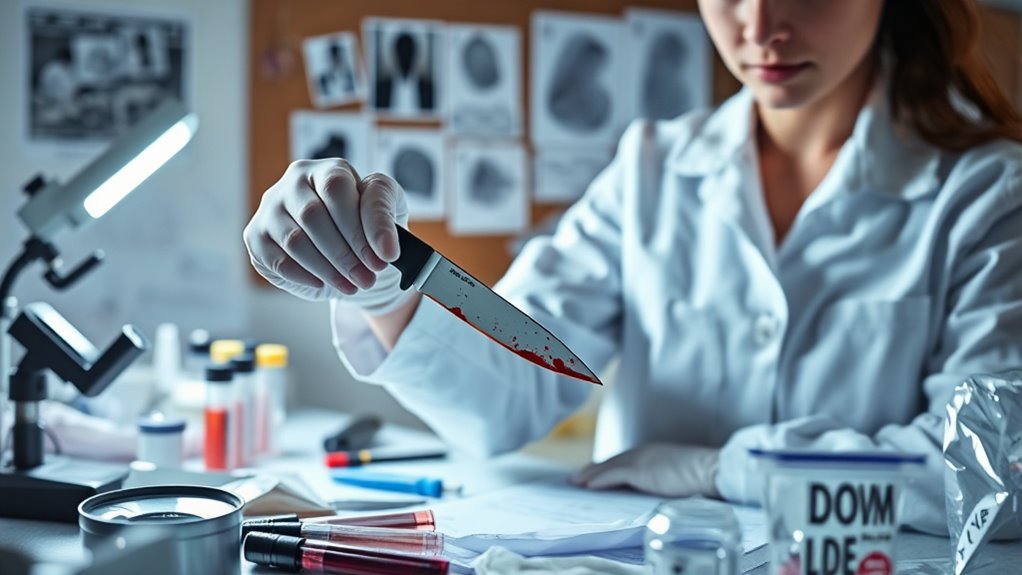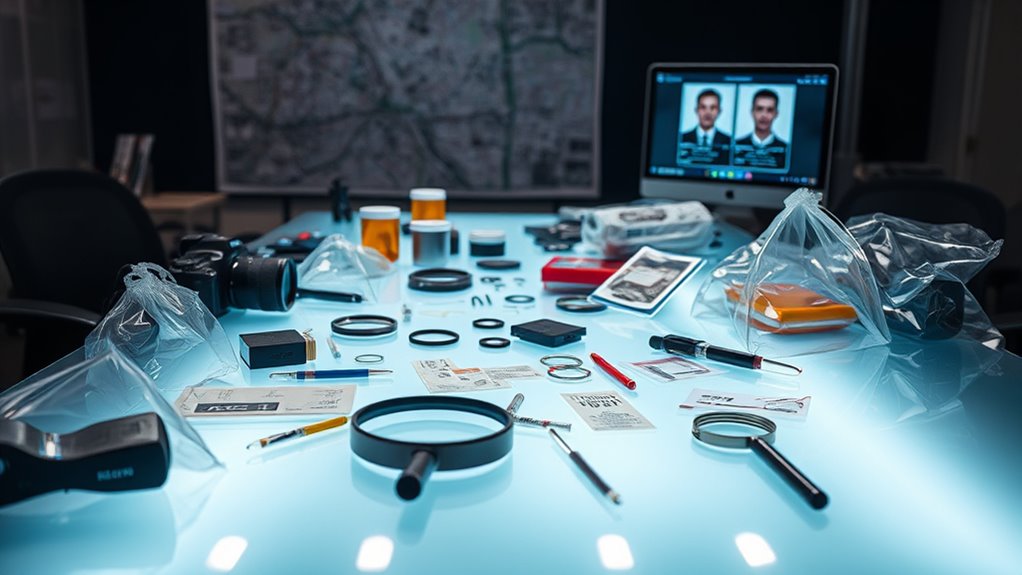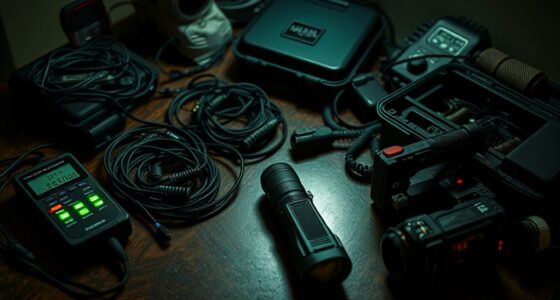After securing a crime scene, you carefully analyze evidence by documenting it thoroughly, including photographing, sketching, and labeling items. You use forensic techniques like fingerprint dusting, DNA swabs, and chemical tests to identify vital clues. Maintaining the chain of custody and proper storage guarantees evidence stays uncontaminated and admissible. Following strict protocols, you combine traditional and digital methods to uncover details and build a credible case. Keep exploring to find out how this process unravels further.
Key Takeaways
- Investigators document and photograph evidence promptly to preserve its original state and maintain a clear chain of custody.
- Forensic techniques like fingerprint dusting, DNA swabbing, and chemical testing analyze evidence for investigative leads.
- Evidence is carefully labeled, sealed, and stored under controlled conditions to prevent contamination or degradation.
- Forensic analysts ensure results are scientifically valid through quality assurance measures and collaboration with specialists.
- Digital forensics uncover hidden data, reconstruct events, and enhance case understanding through advanced technological analysis.

Have investigators uncovered vital clues? When you’re on the scene, every detail matters, and your first priority is to secure evidence properly. Forensic techniques play a crucial role here, guiding you through the meticulous process of evidence preservation. This isn’t just about collecting items; it’s about ensuring that the integrity of each piece remains intact for later analysis. You carefully document everything—photographing the scene from multiple angles, sketching layouts, and noting every item of interest. This initial step prevents contamination and maintains the chain of custody, which is essential for court proceedings. Proper evidence preservation means sealing evidence in appropriate containers, labeling each piece accurately, and storing them under controlled conditions to prevent degradation. Without rigorous attention to these details, the evidence could be compromised, jeopardizing the entire investigation.
Securing and documenting evidence is vital for integrity and court success.
Once the evidence is secured, you turn to forensic techniques to analyze what you’ve gathered. These methods are highly specialized, designed to extract maximum information while maintaining scientific validity. For example, fingerprint analysis involves dusting surfaces with powders or using superglue fuming to reveal prints. DNA analysis might require swabbing biological material and running tests in a lab equipped with advanced machinery. Ballistics experts examine firearms and bullets, comparing markings to identify weapons used. Chemical tests detect traces of drugs, toxins, or accelerants, providing clues about motives or events. Each technique demands precision and adherence to strict protocols, ensuring that the results are reliable and admissible in court. Additionally, quality assurance measures are implemented throughout forensic analysis to maintain accuracy and consistency.
The process of evidence analysis is methodical. You work closely with lab technicians and forensic specialists, sharing observations and hypotheses. As new information emerges, you refine your focus, directing tests toward the most promising leads. This iterative approach helps build a comprehensive picture of what transpired. You also rely heavily on technology—digital forensics allows you to recover deleted files, analyze emails, or trace online activity. Incorporating advanced forensic techniques further enhances your ability to uncover hidden evidence and reconstruct events accurately. The combination of traditional forensic techniques and cutting-edge digital analysis broadens your understanding of complex cases.
Throughout this entire process, evidence preservation remains paramount. You’re aware that mishandling or neglecting proper procedures can lead to evidence being deemed inadmissible or, worse, overlooked entirely. Every step, from collection to analysis, is executed with precision, ensuring the integrity of the evidence and the credibility of your investigation. As you piece together clues, you move closer to uncovering the truth, confident that your meticulous approach will stand up in court and ultimately help deliver justice.
Frequently Asked Questions
How Do Investigators Handle Contaminated Evidence?
When you handle contaminated evidence, you must follow strict protocols to prevent further contamination and maintain the integrity of the chain of custody. You carefully document every step, use proper protective gear, and isolate the evidence from others. If contamination occurs, you notify your team immediately, and experts may re-test or re-collect evidence to guarantee accurate analysis. This approach ensures the evidence remains reliable for investigation and court proceedings.
What New Technologies Aid Evidence Analysis?
Did you know that over 80% of crime labs now use new technologies for evidence analysis? You can leverage DNA sequencing to identify suspects quickly and accurately, even from tiny samples. Forensic imaging allows you to digitally recreate crime scenes, providing clearer insights. These tools enhance your ability to analyze evidence efficiently, making investigations more precise and reliable. Embracing these innovations can markedly improve your investigative outcomes.
How Is Cold or Degraded Evidence Examined?
When examining cold or degraded evidence, you follow strict forensic protocols to safeguard its integrity. You carefully document the chain of custody to guarantee evidence remains uncontaminated. You may use advanced techniques like enhanced microscopy or chemical treatments to improve visibility and analyze the evidence. By meticulously maintaining the chain of custody, you ensure the evidence’s credibility, allowing accurate analysis despite its age or condition.
What Training Is Required for Evidence Analysts?
You need specialized training to become an evidence analyst, including understanding the chain of custody to preserve evidence integrity. Most professionals pursue forensic certification, which guarantees you’re skilled in handling, analyzing, and documenting evidence properly. This training covers legal standards, lab techniques, and ethics, preparing you to accurately interpret evidence without contamination or bias. Certification and ongoing education are vital for maintaining credibility and expertise in forensic investigations.
How Do Investigators Ensure Evidence Integrity During Transfer?
You guarantee evidence integrity during transfer by meticulously maintaining the chain of custody, documenting every person who handles it. Use proper evidence storage techniques, like secure, labeled containers, to prevent tampering or contamination. Always follow established protocols for transferring evidence, including sealing and recording transfer details. This process guarantees that the evidence remains unaltered and admissible in court, preserving its credibility throughout the investigation.
Conclusion
Now that you understand how investigators analyze evidence, remember—every clue is a piece of the puzzle, waiting to reveal the bigger picture. Like a skilled artist, they piece together these fragments to uncover the truth hidden beneath the surface. So, next time you hear about a case solved, think of the meticulous work behind the scenes—where each detail becomes a brushstroke in the masterpiece of justice. After all, the devil is in the details.









